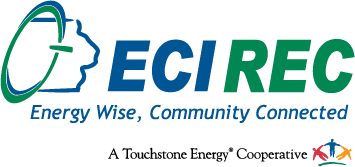ECI REC has a proven track record of supporting economic development, while simultaneously delivering power that is affordable, safe, reliable, and environmentally responsible. Through our programs and services, we help new businesses to locate in our service territory and assist existing businesses, including agricultural operations, to expand their operations.
To ensure all electrical needs are adequately met, we plan for system reliability and safety. Electrical systems must be installed according to applicable codes and maintained and operated in compliance with established standards. ECI REC and Central Iowa Power Cooperative (CIPCO), our generation and transmission cooperative, have robust plans for the construction, operation, inspection, and maintenance of our systems. The state of Iowa provides regulatory oversight of all electric utilities’ written inspection and maintenance plans. While the regulation for safety and reliability resides at the state level, your locally elected Cooperative Board members are typically responsible for the economic regulation, including policies for line or system upgrades.
When line or system upgrades are necessary to serve load growth, some costs are assigned to specific groups based on the configuration of our electric delivery system. This can vary for residential, commercial, and industrial member-consumers.
For example, power line upgrades may be necessary to effectively meet the demands of load growth in a commercial or industrial setting. In those instances, when a concentrated area such as an industrial park is being served, it is generally easier for ECI REC to plan for load growth and the subsequent costs of upgrades, which may in turn be shared among that specific customer group. When initially designing the electric delivery system to serve a large load center, we have an enhanced ability to anticipate and plan for load growth, which can help to minimize the cost impact of future upgrades.
In our more rural, agricultural settings, member-owners are more geographically spread out or closer to the end of the physical power line configuration. When we have a farther distance to build or upgrade lines, the more cost-intensive the project is for ECI REC. In these cases, oftentimes only one or just a handful of people will benefit from system upgrades.
Therefore, it may not be appropriate to charge all member-owners for these costs. For example, if a member-owner builds a home into a very remote area of the woods, should that person pay for the cost to get the line into the woods or should that cost be borne by all member-owners? Electric utilities review who benefits from the extensions or upgrades, and then the costs are generally assigned to those who benefit.
If you are considering a significant change to your electrical needs, or if you are planning to add a distributed generation system on your property, contact ECI REC at the outset of your planning process.
When we have the ability to plan for your service needs, we can continue to provide you with safe, reliable, and affordable electric service.
Other Cost Factors
Beyond the basic costs of building and maintaining infrastructure, many factors are currently placing additional cost pressures on providing electric service, including:
• Reduced energy sales or limited kilowatt-hour sales growth.
• Technology changes.
• Increasing federal and state laws and rules from the legislative, judicial, and executive branches of government.
• Requirements related to electric facilities such as burying lines underground for aesthetic reasons.
• Installation of distributed generation from various fuel sources, including wind, solar, and methane.
